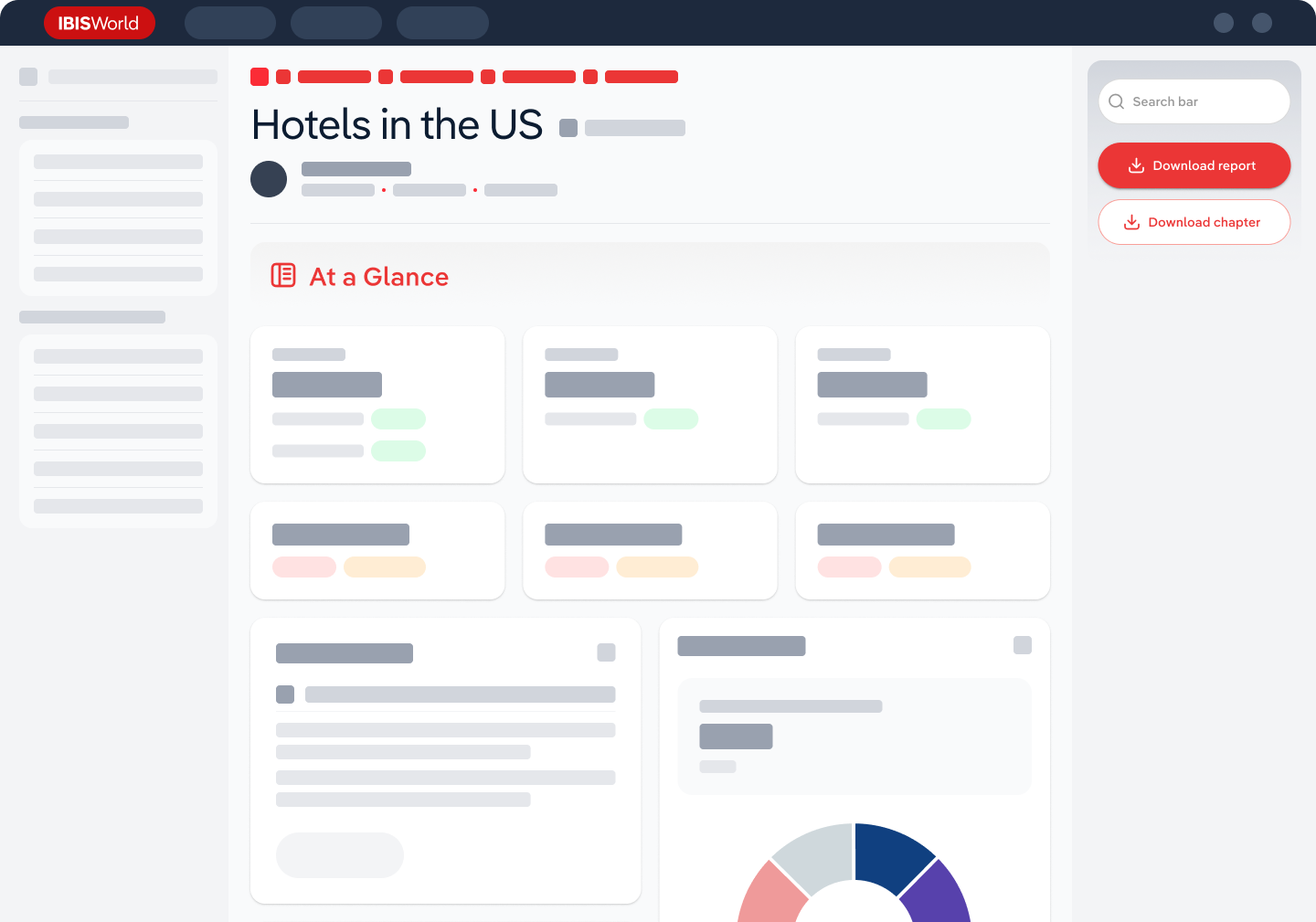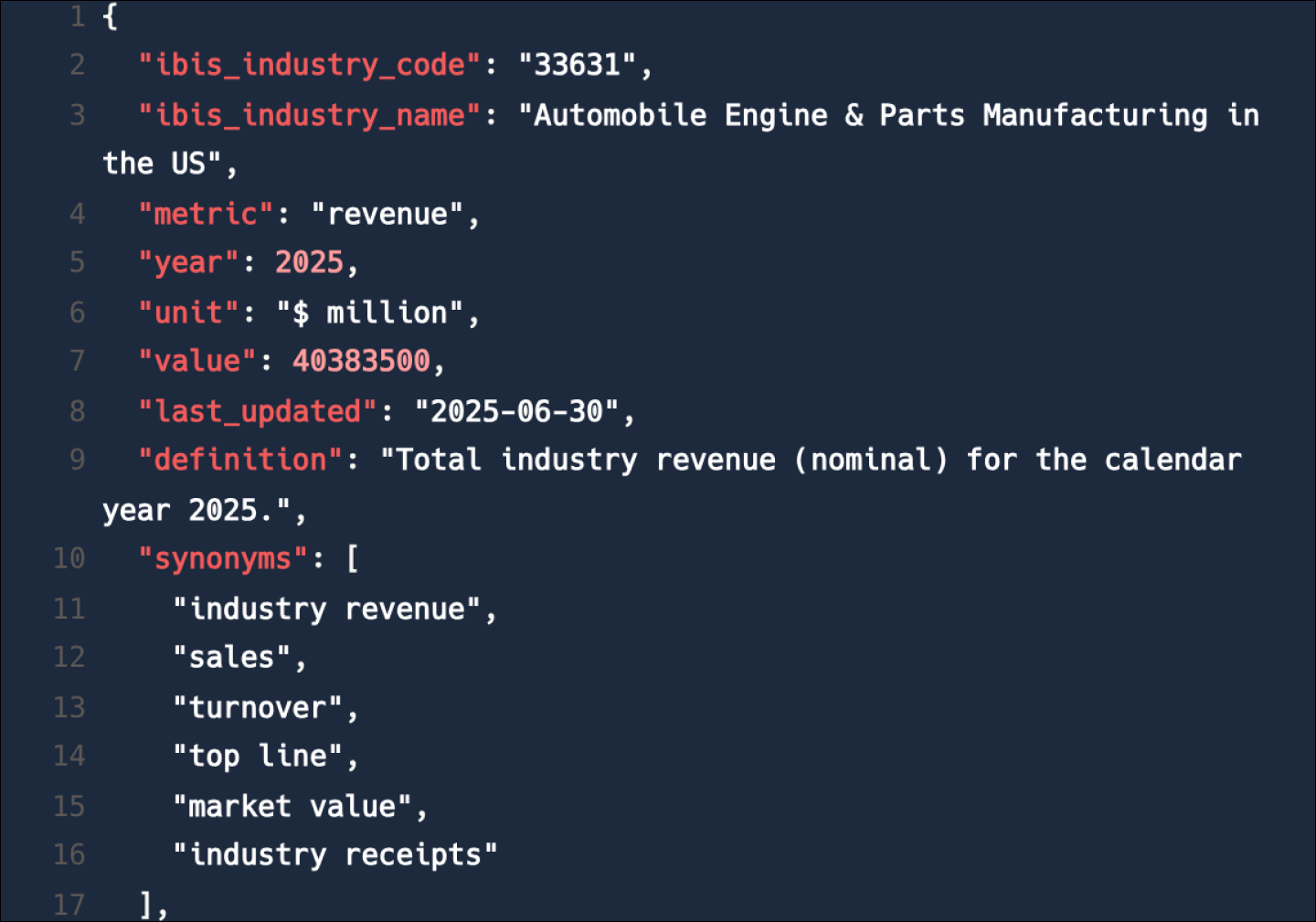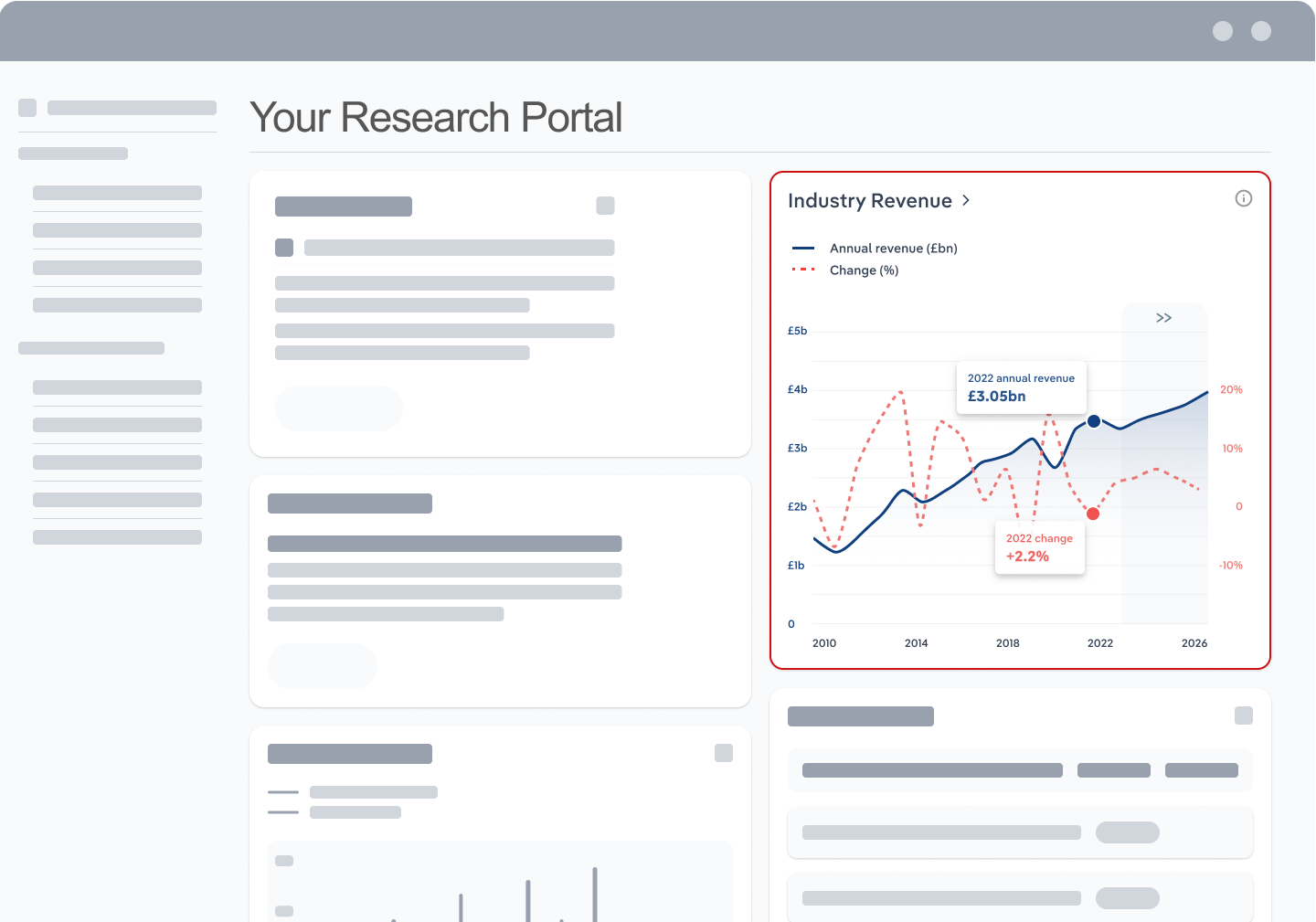Industry Statistics and Trends
Market size and recent performance (2015-2030)
Industry revenue has grown at a CAGR of 23.0 % over the past five years, to reach an estimated $837.0bn in 2025.
Trends and Insights
Airlines expand fleets and leverage leasing to meet travel surges
- Global air travel has shown a robust recovery following the challenges of the pandemic. The UN Tourism Organization estimates that international tourist arrivals reached 1.4 billion in 2024, aligning with levels seen in 2019. IATA data indicates that the passenger load factor, which measures the proportion of seats occupied on flights, increased markedly from 65.2% in 2020 to 83.5% in 2024. This upward trend demonstrates that airlines have effectively accommodated increased demand as travel activity returns to the global stage.
- Additional trends and insights available with purchase
Industry outlook (2025-2030)
Market size is projected to grow over the next five years.
Trends and Insights
Rising affluence in Asia and the Middle East shifts global airline demand
- According to a 2025 McKinsey and Oxford Economics survey, affluent travelers from the Middle East and Northeast Asia will account for 30.0% of the global traveler base by 2030, up from their share in 2023. Meanwhile, traditional tourism markets in Europe and America are projected to see their share of global tourism spending drop from 57.0% to 49.0% in that same period. These shifts suggest airlines will face a more diversified and international traveler demographic, increasing demand driven by new income growth in previously less dominant regions.
Biggest companies in the Global Airlines
| Company | Market Share (%)
2025 | Revenue ($m)
2025 | Profit ($m)
2025 | Profit Margin (%)
2025 |
|---|---|---|---|---|
United | 58,644.0 | 4,734.9 | 8.1 | |
Delta | 56,650.1 | 4,636.2 | 8.2 | |
American Airlines | 54,542.0 | 1,669.4 | 3.1 |
To view the market share and analysis for all 6 top companies in this industry, view purchase options.
Products & Services Segmentation
Industry revenue is measured across several distinct product and services lines, including Cargo transportation, Domestic passenger transportation and International passenger transportation. Cargo transportation is the largest segment of the Global Airlines.
Trends and Insights
Domestic passenger services continue to drive growth in global airlines
- Domestic passenger transportation services refer to scheduled flights operating within a single country, connecting cities and regions for business, leisure and essential travel. High-frequency, short-to-medium-haul routes characterize these services and are crucial to national mobility. They're also the most significant revenue segment for airlines, serving many travelers—commuters, families and businesspeople—who depend on air travel for routine and urgent needs.
- More insights available in the full report
Table of Contents
About this industry
Industry definition
The industry primarily transports passengers who purchase tickets for specific destinations. Although some passenger aircraft also carry cargo, airlines exclusively handling freight are not part of this industry.
What's included in this industry?
Products and services covered in the Global Airlines industry include Cargo transportation, Domestic passenger transportation and International passenger transportation.Companies
Companies covered in the Global Airlines industry include United, Delta and American Airlines.Purchase this report to view all 6 major companies in this industry.
Related Terms
Related terms covered in the Global Airlines industry include international air transport association (iata), code-sharing agreement and open-skies agreement.Performance
Get an indication of the industry's health through historical, current and forward-looking trends in the performance indicators that make or break businesses.
Analyst insights
Budget carriers and expanded fees are shaking up airline revenue and keeping the industry afloat. Low-cost airlines lure travelers with cheap seats and leverage extra charges...
In this chapter (4)
- Current Performance
- Outlook
- Volatility
- Life Cycle
Key metrics
- Annual Revenue, Recent Growth, Forecast, Revenue Volatility
- Number of Employees, Recent Growth, Forecast, Employees per Business, Revenue per Employee
- Number of Businesses, Recent Growth, Forecast, Employees per Business, Revenue per Business
- Total Profit, Profit Margin, Profit per Business
Charts
- Revenue, including historical (2015-2024) and forecast (2025-2030)
- Employees, including historical (2015-2024) and forecast (2025-2030)
- Businesses, including historical (2015-2024) and forecast (2025-2030)
- Profit, including historical (2015-2025)
- Industry Volatility vs. Revenue Growth
- Industry Life Cycle
Detailed analysis
- Trends in supply, demand and current events that are driving current industry performance
- Expected trends, economic factors and ongoing events that drive the industry's outlook
- Key success factors for businesses to overcome volatility
- How contribution to GDP, industry saturation, innovation, consolidation, and technology and systems influence the industry's life cycle phase.
Products and Markets
Learn about an industry's products and services, markets and trends in international trade.
Analyst insight
Domestic air travel is powering most global airline growth these days. Rising incomes and surging demand have pushed domestic travel beyond pre-2019 volumes, keeping planes f...
In this chapter
- Products & Services
- Major Markets
Key metrics
- Largest market segment and value in 2025
- Product innovation level
Charts
- Products & services segmentation in 2025
- Major market segmentation in 2025
Detailed analysis
- Trends impacting the recent performance of the industry's various segments
- Innovations in the industry's product or service offering, specialization or delivery method
- Key factors that successful businesses consider in their offerings
- Buying segments and key trends influencing demand for industry products and services
Geographic Breakdown
Discover where business activity is most concentrated in an industry and the factors driving these trends to find opportunities and conduct regional benchmarking.
Analyst insights
Airlines establish their operations near busy airports. This strategy allows them to reach the most significant number of travelers simultaneously.
In this chapter (1)
- Business Locations
Charts
- Share of revenue, establishment, wages and employment in each region
- Share of population compared to establishments in each region in 2025
Tables
- Number and share of establishments in each region in 2025
- Number and share of revenue each region accounts for in 2025
- Number and share of wages each region accounts for in 2025
- Number and share of employees in each region in 2025
Detailed analysis
- Business Locations Charts
- Share of global output by region in 2025
- Share of population compared to output in each region in 2025
- Data tables
- Share of global output by region in 2025
- Detailed analysis
- Geographic spread of the industry across Global, and trends associated with changes in the business landscape
- Key success factors for businesses to use location to their advantage
Competitive Forces
Get data and insights on what's driving competition in an industry and the challenges industry operators and new entrants may face, with analysis built around Porter's Five Forces framework.
Analyst insights
Launching an airline isn’t affordable, making high start-up costs a big hurdle for entrants. Significant investments are needed for equipment, space, skilled staff and strict...
In this chapter (4)
- Concentration
- Barriers to Entry
- Substitutes
- Buyer & Supplier Analysis
Key metrics
- Industry concentration level
- Industry competition level and trend
- Barriers to entry level and trend
- Substitutes level and trend
- Buyer power level and trend
- Supplier power level and trend
Charts
- Market share concentration among the top 4 suppliers from 2020-2025
- Supply chain including upstream supplying industries and downstream buying industries, flow chart
Detailed analysis
- Factors impacting the industry’s level of concentration, such as business distribution, new entrants, or merger and acquisition activity.
- Key success factors for businesses to manage the competitive environment of the industry.
- Challenges that potential industry entrants face such as legal, start-up costs, differentiation, labor/capital intensity and capital expenses.
- Key success factors for potential entrants to overcome barriers to entry.
- Competitive threats from potential substitutes for the industry’s own products and services.
- Key success factors for how successful businesses can compete with substitutes.
- Advantages that buyers have to keep favorable purchasing conditions.
- Advantages that suppliers have to maintain favorable selling conditions.
- Key success factors for how businesses can navigate buyer and supplier power.
Companies
Learn about the performance of the top companies in the industry.
Analyst insights
Airlines strive to minimize their environmental footprint. Many leading carriers focus on greater sustainability by adopting eco-friendly fuels and upgrading to aircraft with...
In this chapter
- Market Share Concentration
- Companies
- Company Spotlights
Charts
- Industry market share by company in 2021 through 2025
- Major companies in the industry, including market share, revenue, profit and profit margin in 2025
- Overview of United's performance by revenue, market share and profit margin from 2019 through 2025
- Overview of Delta's performance by revenue, market share and profit margin from 2019 through 2025
- Overview of American Airlines's performance by revenue, market share and profit margin from 2019 through 2025
- Overview of revenue, market share and profit margin trend for 3 additional companies
Detailed analysis
- Description and key data for United, and factors influencing its performance in the industry
- Description and key data for Delta, and factors influencing its performance in the industry
- Description and key data for American Airlines, and factors influencing its performance in the industry
- Description, key data and performance trends for 3 additional companies
External Environment
Understand the demographic, economic and regulatory factors that shape how businesses in an industry perform.
Analyst insights
When oil prices climb, airlines often respond by raising ticket prices. This allows them to offset higher operating expenses by transferring costs to passengers, which can bo...
In this chapter
- External Drivers
- Regulation & Policy
- Assistance
Key metrics
- Regulation & policy level and trend
- Assistance level and trend
Charts
- Regulation & Policy historical data and forecast (2015-2030)
- Assistance historical data and forecast (2015-2030)
Detailed analysis
- Demographic and macroeconomic factors influencing the industry, including Regulation & Policy and Assistance
- Major types of regulations, regulatory bodies, industry standards or specific regulations impacting requirements for industry operators
- Key governmental and non-governmental groups or policies that may provide some relief for industry operators.
Financial Benchmarks
View average costs for industry operators and compare financial data against an industry's financial benchmarks over time.
Analyst insights
Airlines are regaining profit with baggage and seat fees, but rising costs keep pre-pandemic earnings out of reach. Despite expanding add-on charges, expenses like labor and ...
In this chapter
- Cost Structure
- Financial Ratios
- Key Ratios
Key metrics
- Profit margin, and how it compares to the sector-wide margin
- Average wages, and how it compares to the sector-wide average wage
- Largest cost component as a percentage of revenue
- Industry average ratios for days' receivables, industry coverage and debt-to-net-worth ratio
Charts
- Average industry operating costs as a share of revenue, including purchases, wages, depreciation, utilities, rent, other costs and profit in 2025
- Average sector operating costs as a share of revenue, including purchases, wages, depreciation, utilities, rent, other costs and profit in 2025
- Investment vs. share of economy
Data tables
- Cash Flow & Debt Service Ratios (2015-2030)
- Revenue per Employee (2015-2030)
- Revenue per Enterprise (2015-2030)
- Employees per Establishment (2015-2030)
- Employees per Enterprise (2015-2030)
- Average Wage (2015-2030)
- Wages/Revenue (2015-2030)
- Establishments per Enterprise (2015-2030)
- IVA/Revenue (2015-2030)
- Imports/Demand (2015-2030)
- Exports/Revenue (2015-2030)
Detailed analysis
- Trends in the cost component for industry operators and their impact on industry costs and profitability
Key Statistics
Industry Data
Data Tables
Including values and annual change:
- Revenue (2015-2030)
- IVA (2015-2030)
- Establishments (2015-2030)
- Enterprises (2015-2030)
- Employment (2015-2030)
- Exports (2015-2030)
- Imports (2015-2030)
- Wages (2015-2030)
Top Questions Answered
Unlock comprehensive answers and precise data upon purchase. View purchase options.
What is the market size of the Global Airlines industry in 2025?
The market size of the Global Airlines industry is $837.0bn in 2025.
How many businesses are there in the Global Airlines industry in 2025?
There are 6,901 businesses in the Global Airlines industry, which has grown at a CAGR of 24.7 % between 2020 and 2025.
How may import tariffs affect the Global Airlines industry?
The Global Airlines industry is unlikely to be materially impacted by import tariffs with imports accounting for a low share of industry revenue.
How may export tariffs affect the Global Airlines industry?
The Global Airlines industry is unlikely to be materially impacted by export tariffs with exports accounting for a low share of industry revenue.
Has the Global Airlines industry grown or declined over the past 5 years?
The market size of the Global Airlines industry has been growing at a CAGR of 23.0 % between 2020 and 2025.
What is the forecast growth of the Global Airlines industry over the next 5 years?
Over the next five years, the Global Airlines industry is expected to grow.
What are the biggest companies in the Global Airlines industry?
The biggest companies operating in the Global Airlines industry are United, Delta and American Airlines
What does the Global Airlines industry include?
Cargo transportation and Domestic passenger transportation are part of the Global Airlines industry.
Which companies have the highest market share in the Global Airlines industry?
The company holding the most market share in the Global Airlines industry is United.
How competitive is the Global Airlines industry?
The level of competition is low and increasing in the Global Airlines industry.
Methodology
How are IBISWorld reports created?
IBISWorld has been a leading provider of trusted industry research for over 50 years to the most successful companies worldwide. With offices in Australia, the United States, the United Kingdom, Germany and China, we are proud to have local teams of analysts that conduct research, data analysis and forecasting to produce data-driven industry reports.
Our analysts start with official, verified and publicly available sources of data to build the most accurate picture of each industry. Analysts then leverage their expertise and knowledge of the local markets to synthesize trends into digestible content for IBISWorld readers. Finally, each report is reviewed by one of IBISWorld’s editors, who provide quality assurance to ensure accuracy and readability.
IBISWorld relies on human-verified data and human-written analysis to compile each standard industry report. We do not use generative AI tools to write insights, although members can choose to leverage AI-based tools within the platform to generate additional analysis formats.
What data sources do IBISWorld analysts use?
Each industry report incorporates data and research from government databases, industry-specific sources, industry contacts, and our own proprietary database of statistics and analysis to provide balanced, independent and accurate insights.
Key data sources globally include:
- United Nations Comtrade
- Organization for Economic Cooperation & Development
- World Bank
Analysts also use industry specific sources to complement catch-all sources, although their perspective may focus on a particular organization or representative body, rather than a clear overview of all industry operations. However, when balanced against other perspectives, industry-specific sources provide insights into industry trends.
These sources include:
- Industry and trade associations
- Industry federations or regulators
- Major industry players annual or quarterly filings
Finally, IBISWorld’s global data scientists maintain a proprietary database of macroeconomic and demand drivers, which our analysts use to help inform industry data and trends. They also maintain a database of statistics and analysis on thousands of industries, which has been built over our more than 50-year history and offers comprehensive insights into long-term trends.
How does IBISWorld forecast its data?
IBISWorld’s analysts and data scientists use the sources above to create forecasts for our proprietary datasets and industry statistics. Depending on the dataset, they may use regression analysis, multivariate analysis, time-series analysis or exponential smoothing techniques to project future data for the industry or driver. Additionally, analysts will leverage their local knowledge of industry operating and regulatory conditions to impart their best judgment on the forecast model.
IBISWorld prides itself on being a trusted, independent source of data, with over 50 years of experience building and maintaining rich datasets and forecasting tools. We are proud to be the keystone source of industry information for thousands of companies across the world.
Learn more about our methodology and data sourcing on the Help Center.










